Business Research Report: Stakeholder Theory, Learning Log Analysis
VerifiedAdded on 2020/01/07
|10
|3107
|163
Report
AI Summary
This business research report is divided into two parts. Part 1 critically evaluates stakeholder theory by analyzing selected articles from the Journal of Business Ethics, International Business Review, and Organizational Science, focusing on their ABS rankings, literature search methods, and rationale for article selection. The report discusses the description, background, and critical evaluation of these articles, summarizing key findings related to returnee entities, stakeholder pressure, and organizational ethics. Part 2 presents a learning log, applying hypothesis testing to a business scenario. It formulates null and alternative hypotheses, calculates Z-scores, and interprets P-values to determine the significance of differences in profit per employee compared to industry averages. The report concludes by summarizing the findings and emphasizing the importance of balancing stakeholder interests with company objectives.
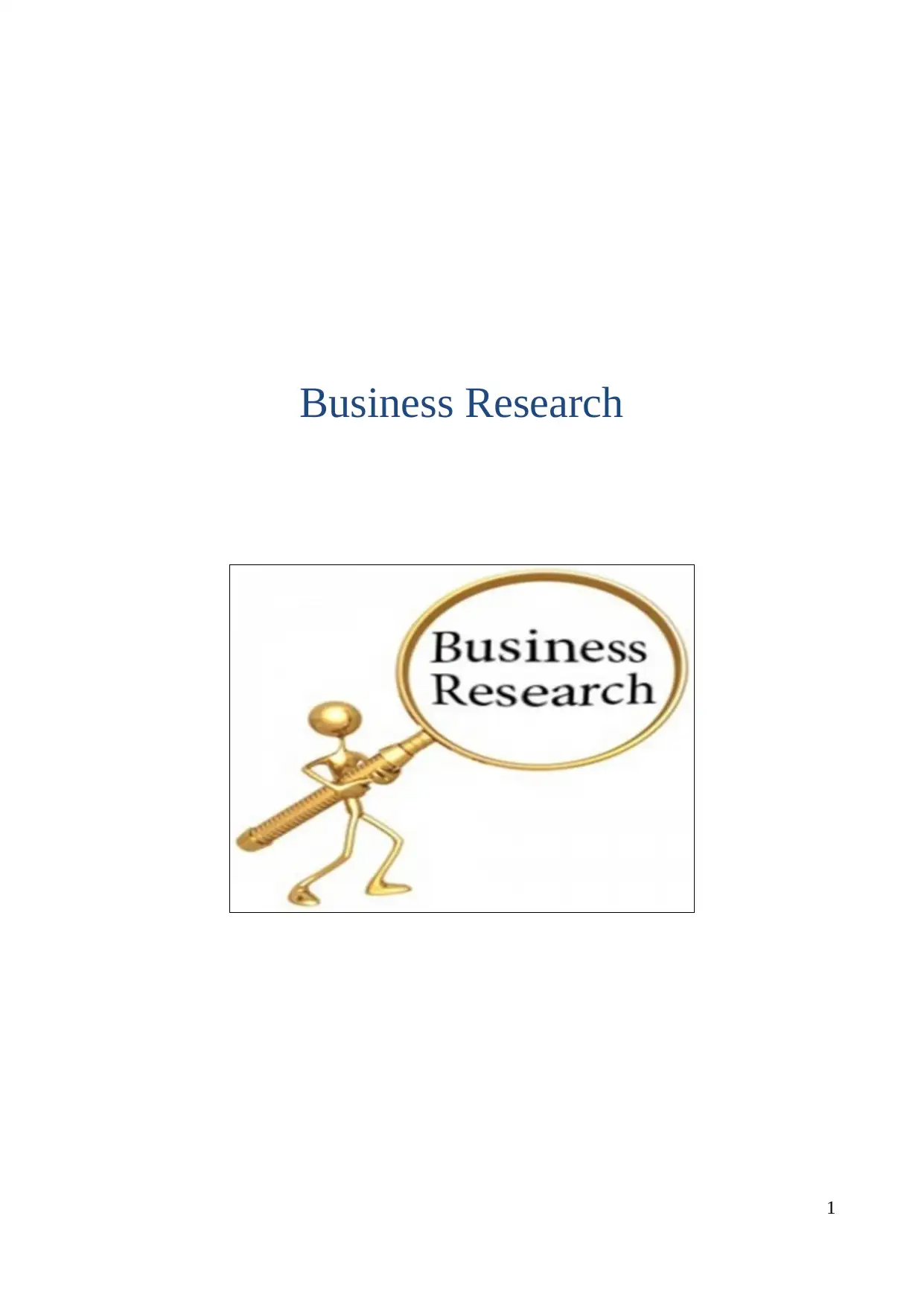
Business Research
1
1
Paraphrase This Document
Need a fresh take? Get an instant paraphrase of this document with our AI Paraphraser
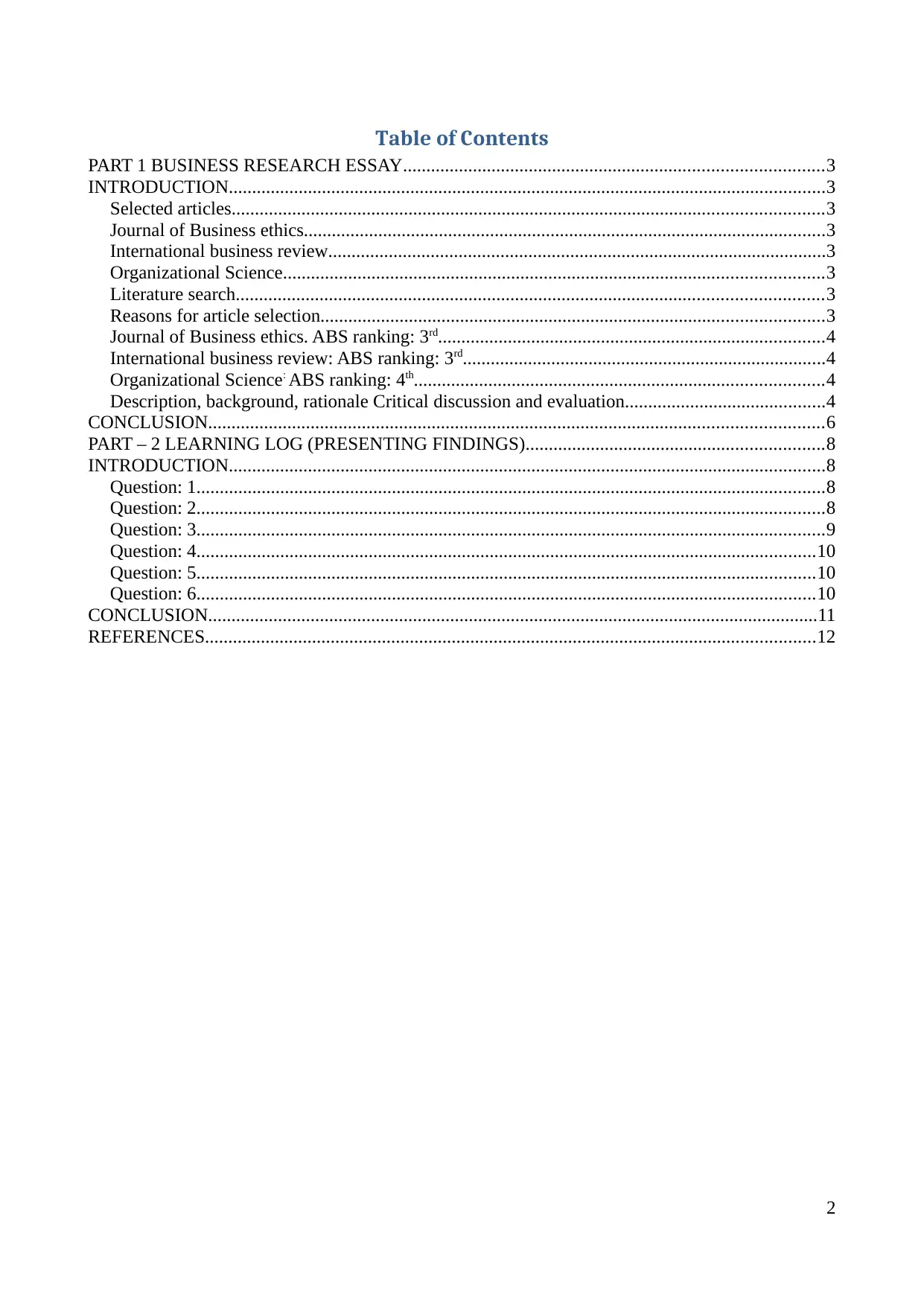
Table of Contents
PART 1 BUSINESS RESEARCH ESSAY..........................................................................................3
INTRODUCTION................................................................................................................................3
Selected articles...............................................................................................................................3
Journal of Business ethics................................................................................................................3
International business review...........................................................................................................3
Organizational Science....................................................................................................................3
Literature search..............................................................................................................................3
Reasons for article selection............................................................................................................3
Journal of Business ethics. ABS ranking: 3rd...................................................................................4
International business review: ABS ranking: 3rd..............................................................................4
Organizational Science: ABS ranking: 4th........................................................................................4
Description, background, rationale Critical discussion and evaluation...........................................4
CONCLUSION....................................................................................................................................6
PART – 2 LEARNING LOG (PRESENTING FINDINGS)................................................................8
INTRODUCTION................................................................................................................................8
Question: 1.......................................................................................................................................8
Question: 2.......................................................................................................................................8
Question: 3.......................................................................................................................................9
Question: 4.....................................................................................................................................10
Question: 5.....................................................................................................................................10
Question: 6.....................................................................................................................................10
CONCLUSION...................................................................................................................................11
REFERENCES...................................................................................................................................12
2
PART 1 BUSINESS RESEARCH ESSAY..........................................................................................3
INTRODUCTION................................................................................................................................3
Selected articles...............................................................................................................................3
Journal of Business ethics................................................................................................................3
International business review...........................................................................................................3
Organizational Science....................................................................................................................3
Literature search..............................................................................................................................3
Reasons for article selection............................................................................................................3
Journal of Business ethics. ABS ranking: 3rd...................................................................................4
International business review: ABS ranking: 3rd..............................................................................4
Organizational Science: ABS ranking: 4th........................................................................................4
Description, background, rationale Critical discussion and evaluation...........................................4
CONCLUSION....................................................................................................................................6
PART – 2 LEARNING LOG (PRESENTING FINDINGS)................................................................8
INTRODUCTION................................................................................................................................8
Question: 1.......................................................................................................................................8
Question: 2.......................................................................................................................................8
Question: 3.......................................................................................................................................9
Question: 4.....................................................................................................................................10
Question: 5.....................................................................................................................................10
Question: 6.....................................................................................................................................10
CONCLUSION...................................................................................................................................11
REFERENCES...................................................................................................................................12
2
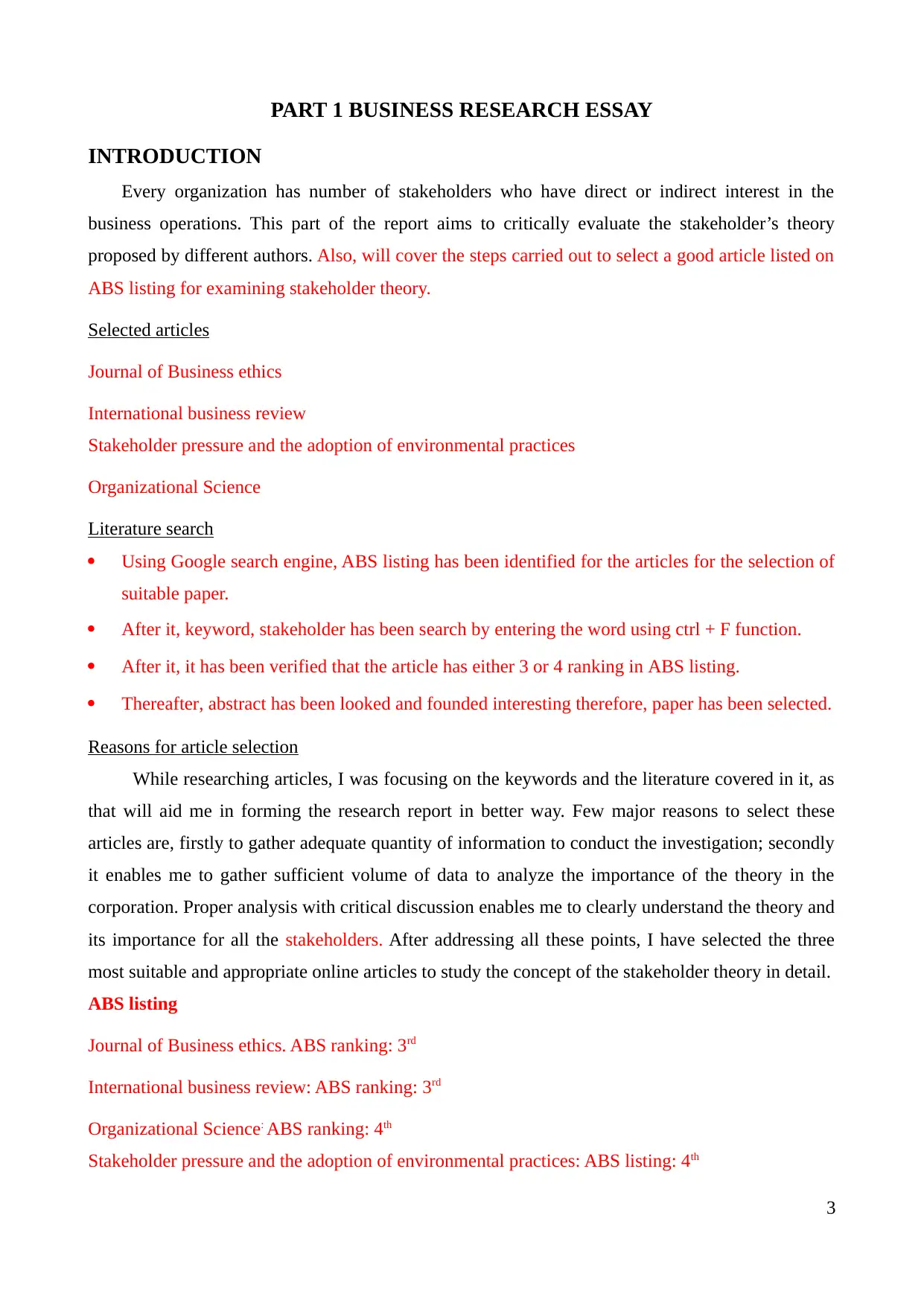
PART 1 BUSINESS RESEARCH ESSAY
INTRODUCTION
Every organization has number of stakeholders who have direct or indirect interest in the
business operations. This part of the report aims to critically evaluate the stakeholder’s theory
proposed by different authors. Also, will cover the steps carried out to select a good article listed on
ABS listing for examining stakeholder theory.
Selected articles
Journal of Business ethics
International business review
Stakeholder pressure and the adoption of environmental practices
Organizational Science
Literature search
Using Google search engine, ABS listing has been identified for the articles for the selection of
suitable paper.
After it, keyword, stakeholder has been search by entering the word using ctrl + F function.
After it, it has been verified that the article has either 3 or 4 ranking in ABS listing.
Thereafter, abstract has been looked and founded interesting therefore, paper has been selected.
Reasons for article selection
While researching articles, I was focusing on the keywords and the literature covered in it, as
that will aid me in forming the research report in better way. Few major reasons to select these
articles are, firstly to gather adequate quantity of information to conduct the investigation; secondly
it enables me to gather sufficient volume of data to analyze the importance of the theory in the
corporation. Proper analysis with critical discussion enables me to clearly understand the theory and
its importance for all the stakeholders. After addressing all these points, I have selected the three
most suitable and appropriate online articles to study the concept of the stakeholder theory in detail.
ABS listing
Journal of Business ethics. ABS ranking: 3rd
International business review: ABS ranking: 3rd
Organizational Science: ABS ranking: 4th
Stakeholder pressure and the adoption of environmental practices: ABS listing: 4th
3
INTRODUCTION
Every organization has number of stakeholders who have direct or indirect interest in the
business operations. This part of the report aims to critically evaluate the stakeholder’s theory
proposed by different authors. Also, will cover the steps carried out to select a good article listed on
ABS listing for examining stakeholder theory.
Selected articles
Journal of Business ethics
International business review
Stakeholder pressure and the adoption of environmental practices
Organizational Science
Literature search
Using Google search engine, ABS listing has been identified for the articles for the selection of
suitable paper.
After it, keyword, stakeholder has been search by entering the word using ctrl + F function.
After it, it has been verified that the article has either 3 or 4 ranking in ABS listing.
Thereafter, abstract has been looked and founded interesting therefore, paper has been selected.
Reasons for article selection
While researching articles, I was focusing on the keywords and the literature covered in it, as
that will aid me in forming the research report in better way. Few major reasons to select these
articles are, firstly to gather adequate quantity of information to conduct the investigation; secondly
it enables me to gather sufficient volume of data to analyze the importance of the theory in the
corporation. Proper analysis with critical discussion enables me to clearly understand the theory and
its importance for all the stakeholders. After addressing all these points, I have selected the three
most suitable and appropriate online articles to study the concept of the stakeholder theory in detail.
ABS listing
Journal of Business ethics. ABS ranking: 3rd
International business review: ABS ranking: 3rd
Organizational Science: ABS ranking: 4th
Stakeholder pressure and the adoption of environmental practices: ABS listing: 4th
3
⊘ This is a preview!⊘
Do you want full access?
Subscribe today to unlock all pages.

Trusted by 1+ million students worldwide
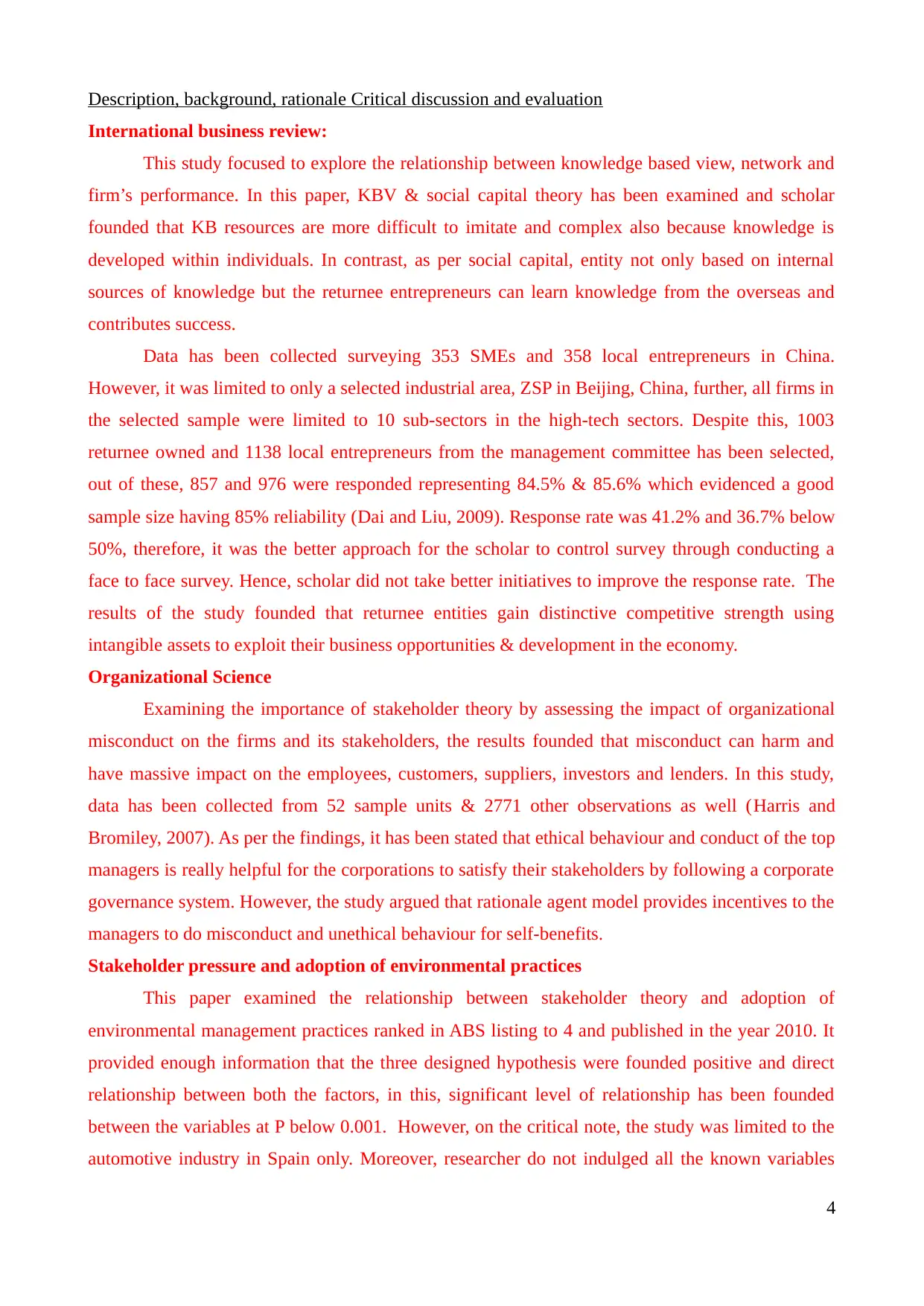
Description, background, rationale Critical discussion and evaluation
International business review:
This study focused to explore the relationship between knowledge based view, network and
firm’s performance. In this paper, KBV & social capital theory has been examined and scholar
founded that KB resources are more difficult to imitate and complex also because knowledge is
developed within individuals. In contrast, as per social capital, entity not only based on internal
sources of knowledge but the returnee entrepreneurs can learn knowledge from the overseas and
contributes success.
Data has been collected surveying 353 SMEs and 358 local entrepreneurs in China.
However, it was limited to only a selected industrial area, ZSP in Beijing, China, further, all firms in
the selected sample were limited to 10 sub-sectors in the high-tech sectors. Despite this, 1003
returnee owned and 1138 local entrepreneurs from the management committee has been selected,
out of these, 857 and 976 were responded representing 84.5% & 85.6% which evidenced a good
sample size having 85% reliability (Dai and Liu, 2009). Response rate was 41.2% and 36.7% below
50%, therefore, it was the better approach for the scholar to control survey through conducting a
face to face survey. Hence, scholar did not take better initiatives to improve the response rate. The
results of the study founded that returnee entities gain distinctive competitive strength using
intangible assets to exploit their business opportunities & development in the economy.
Organizational Science
Examining the importance of stakeholder theory by assessing the impact of organizational
misconduct on the firms and its stakeholders, the results founded that misconduct can harm and
have massive impact on the employees, customers, suppliers, investors and lenders. In this study,
data has been collected from 52 sample units & 2771 other observations as well (Harris and
Bromiley, 2007). As per the findings, it has been stated that ethical behaviour and conduct of the top
managers is really helpful for the corporations to satisfy their stakeholders by following a corporate
governance system. However, the study argued that rationale agent model provides incentives to the
managers to do misconduct and unethical behaviour for self-benefits.
Stakeholder pressure and adoption of environmental practices
This paper examined the relationship between stakeholder theory and adoption of
environmental management practices ranked in ABS listing to 4 and published in the year 2010. It
provided enough information that the three designed hypothesis were founded positive and direct
relationship between both the factors, in this, significant level of relationship has been founded
between the variables at P below 0.001. However, on the critical note, the study was limited to the
automotive industry in Spain only. Moreover, researcher do not indulged all the known variables
4
International business review:
This study focused to explore the relationship between knowledge based view, network and
firm’s performance. In this paper, KBV & social capital theory has been examined and scholar
founded that KB resources are more difficult to imitate and complex also because knowledge is
developed within individuals. In contrast, as per social capital, entity not only based on internal
sources of knowledge but the returnee entrepreneurs can learn knowledge from the overseas and
contributes success.
Data has been collected surveying 353 SMEs and 358 local entrepreneurs in China.
However, it was limited to only a selected industrial area, ZSP in Beijing, China, further, all firms in
the selected sample were limited to 10 sub-sectors in the high-tech sectors. Despite this, 1003
returnee owned and 1138 local entrepreneurs from the management committee has been selected,
out of these, 857 and 976 were responded representing 84.5% & 85.6% which evidenced a good
sample size having 85% reliability (Dai and Liu, 2009). Response rate was 41.2% and 36.7% below
50%, therefore, it was the better approach for the scholar to control survey through conducting a
face to face survey. Hence, scholar did not take better initiatives to improve the response rate. The
results of the study founded that returnee entities gain distinctive competitive strength using
intangible assets to exploit their business opportunities & development in the economy.
Organizational Science
Examining the importance of stakeholder theory by assessing the impact of organizational
misconduct on the firms and its stakeholders, the results founded that misconduct can harm and
have massive impact on the employees, customers, suppliers, investors and lenders. In this study,
data has been collected from 52 sample units & 2771 other observations as well (Harris and
Bromiley, 2007). As per the findings, it has been stated that ethical behaviour and conduct of the top
managers is really helpful for the corporations to satisfy their stakeholders by following a corporate
governance system. However, the study argued that rationale agent model provides incentives to the
managers to do misconduct and unethical behaviour for self-benefits.
Stakeholder pressure and adoption of environmental practices
This paper examined the relationship between stakeholder theory and adoption of
environmental management practices ranked in ABS listing to 4 and published in the year 2010. It
provided enough information that the three designed hypothesis were founded positive and direct
relationship between both the factors, in this, significant level of relationship has been founded
between the variables at P below 0.001. However, on the critical note, the study was limited to the
automotive industry in Spain only. Moreover, researcher do not indulged all the known variables
4
Paraphrase This Document
Need a fresh take? Get an instant paraphrase of this document with our AI Paraphraser
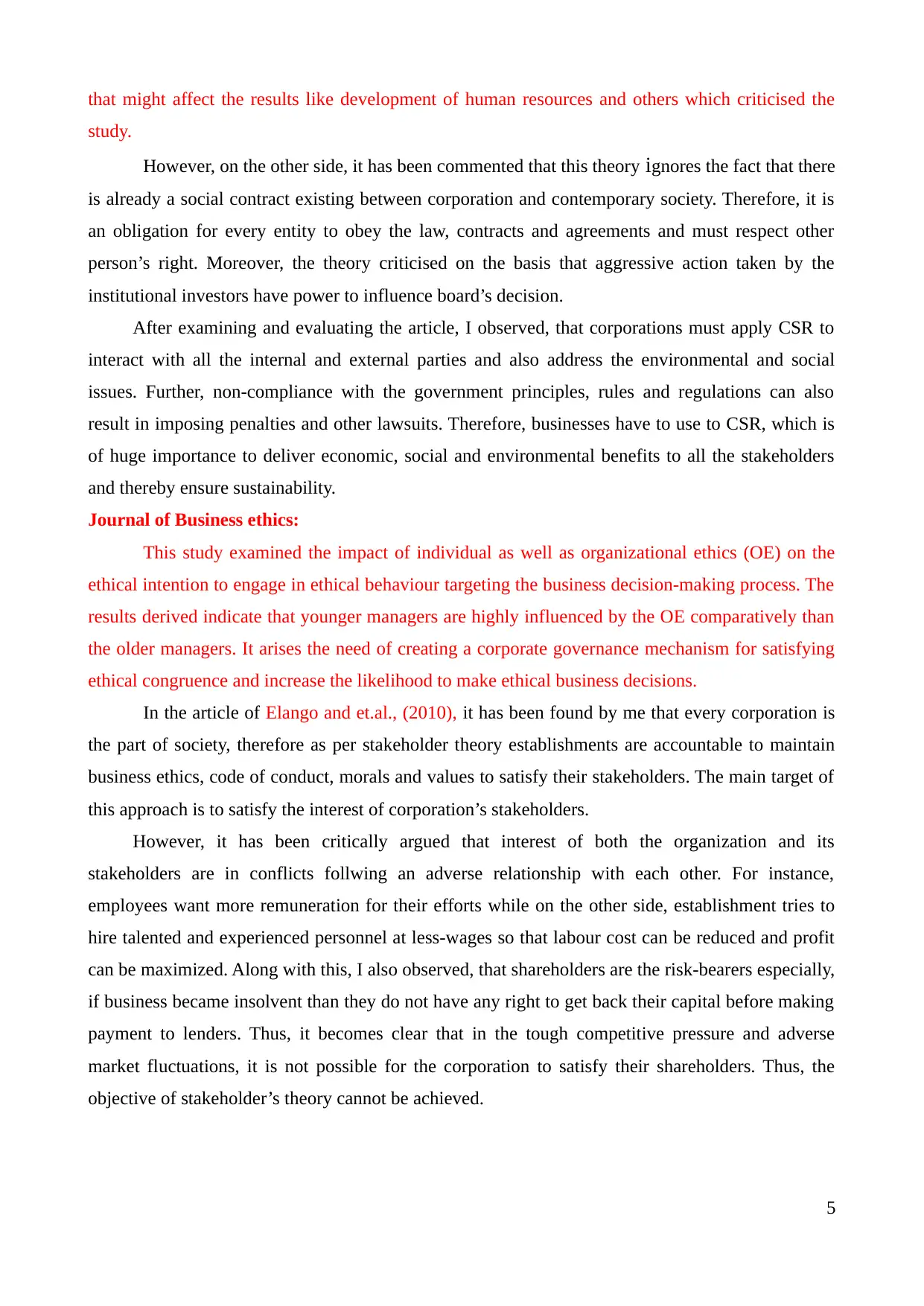
that might affect the results like development of human resources and others which criticised the
study.
However, on the other side, it has been commented that this theory ignores the fact that there
is already a social contract existing between corporation and contemporary society. Therefore, it is
an obligation for every entity to obey the law, contracts and agreements and must respect other
person’s right. Moreover, the theory criticised on the basis that aggressive action taken by the
institutional investors have power to influence board’s decision.
After examining and evaluating the article, I observed, that corporations must apply CSR to
interact with all the internal and external parties and also address the environmental and social
issues. Further, non-compliance with the government principles, rules and regulations can also
result in imposing penalties and other lawsuits. Therefore, businesses have to use to CSR, which is
of huge importance to deliver economic, social and environmental benefits to all the stakeholders
and thereby ensure sustainability.
Journal of Business ethics:
This study examined the impact of individual as well as organizational ethics (OE) on the
ethical intention to engage in ethical behaviour targeting the business decision-making process. The
results derived indicate that younger managers are highly influenced by the OE comparatively than
the older managers. It arises the need of creating a corporate governance mechanism for satisfying
ethical congruence and increase the likelihood to make ethical business decisions.
In the article of Elango and et.al., (2010), it has been found by me that every corporation is
the part of society, therefore as per stakeholder theory establishments are accountable to maintain
business ethics, code of conduct, morals and values to satisfy their stakeholders. The main target of
this approach is to satisfy the interest of corporation’s stakeholders.
However, it has been critically argued that interest of both the organization and its
stakeholders are in conflicts follwing an adverse relationship with each other. For instance,
employees want more remuneration for their efforts while on the other side, establishment tries to
hire talented and experienced personnel at less-wages so that labour cost can be reduced and profit
can be maximized. Along with this, I also observed, that shareholders are the risk-bearers especially,
if business became insolvent than they do not have any right to get back their capital before making
payment to lenders. Thus, it becomes clear that in the tough competitive pressure and adverse
market fluctuations, it is not possible for the corporation to satisfy their shareholders. Thus, the
objective of stakeholder’s theory cannot be achieved.
5
study.
However, on the other side, it has been commented that this theory ignores the fact that there
is already a social contract existing between corporation and contemporary society. Therefore, it is
an obligation for every entity to obey the law, contracts and agreements and must respect other
person’s right. Moreover, the theory criticised on the basis that aggressive action taken by the
institutional investors have power to influence board’s decision.
After examining and evaluating the article, I observed, that corporations must apply CSR to
interact with all the internal and external parties and also address the environmental and social
issues. Further, non-compliance with the government principles, rules and regulations can also
result in imposing penalties and other lawsuits. Therefore, businesses have to use to CSR, which is
of huge importance to deliver economic, social and environmental benefits to all the stakeholders
and thereby ensure sustainability.
Journal of Business ethics:
This study examined the impact of individual as well as organizational ethics (OE) on the
ethical intention to engage in ethical behaviour targeting the business decision-making process. The
results derived indicate that younger managers are highly influenced by the OE comparatively than
the older managers. It arises the need of creating a corporate governance mechanism for satisfying
ethical congruence and increase the likelihood to make ethical business decisions.
In the article of Elango and et.al., (2010), it has been found by me that every corporation is
the part of society, therefore as per stakeholder theory establishments are accountable to maintain
business ethics, code of conduct, morals and values to satisfy their stakeholders. The main target of
this approach is to satisfy the interest of corporation’s stakeholders.
However, it has been critically argued that interest of both the organization and its
stakeholders are in conflicts follwing an adverse relationship with each other. For instance,
employees want more remuneration for their efforts while on the other side, establishment tries to
hire talented and experienced personnel at less-wages so that labour cost can be reduced and profit
can be maximized. Along with this, I also observed, that shareholders are the risk-bearers especially,
if business became insolvent than they do not have any right to get back their capital before making
payment to lenders. Thus, it becomes clear that in the tough competitive pressure and adverse
market fluctuations, it is not possible for the corporation to satisfy their shareholders. Thus, the
objective of stakeholder’s theory cannot be achieved.
5
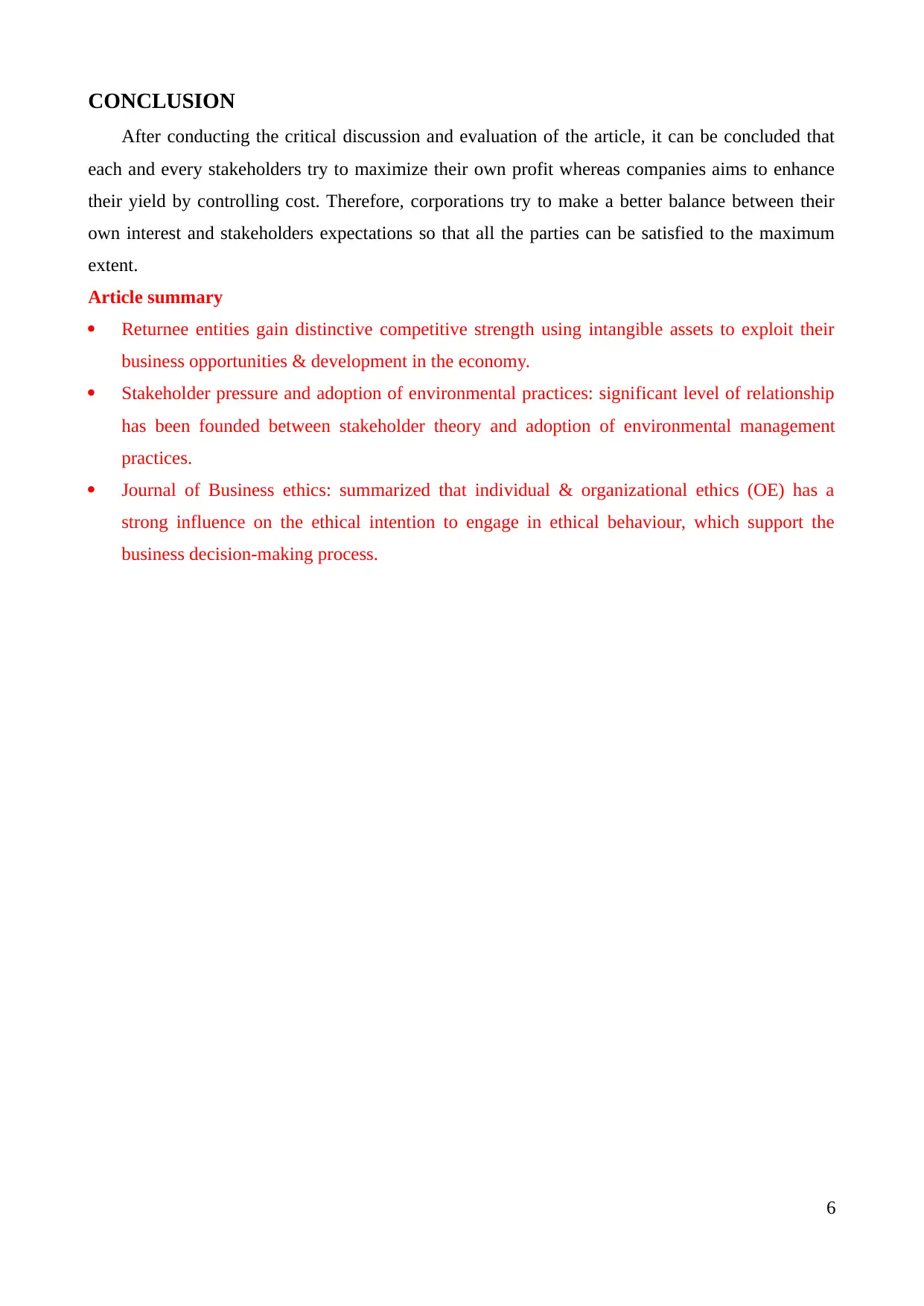
CONCLUSION
After conducting the critical discussion and evaluation of the article, it can be concluded that
each and every stakeholders try to maximize their own profit whereas companies aims to enhance
their yield by controlling cost. Therefore, corporations try to make a better balance between their
own interest and stakeholders expectations so that all the parties can be satisfied to the maximum
extent.
Article summary
Returnee entities gain distinctive competitive strength using intangible assets to exploit their
business opportunities & development in the economy.
Stakeholder pressure and adoption of environmental practices: significant level of relationship
has been founded between stakeholder theory and adoption of environmental management
practices.
Journal of Business ethics: summarized that individual & organizational ethics (OE) has a
strong influence on the ethical intention to engage in ethical behaviour, which support the
business decision-making process.
6
After conducting the critical discussion and evaluation of the article, it can be concluded that
each and every stakeholders try to maximize their own profit whereas companies aims to enhance
their yield by controlling cost. Therefore, corporations try to make a better balance between their
own interest and stakeholders expectations so that all the parties can be satisfied to the maximum
extent.
Article summary
Returnee entities gain distinctive competitive strength using intangible assets to exploit their
business opportunities & development in the economy.
Stakeholder pressure and adoption of environmental practices: significant level of relationship
has been founded between stakeholder theory and adoption of environmental management
practices.
Journal of Business ethics: summarized that individual & organizational ethics (OE) has a
strong influence on the ethical intention to engage in ethical behaviour, which support the
business decision-making process.
6
⊘ This is a preview!⊘
Do you want full access?
Subscribe today to unlock all pages.

Trusted by 1+ million students worldwide
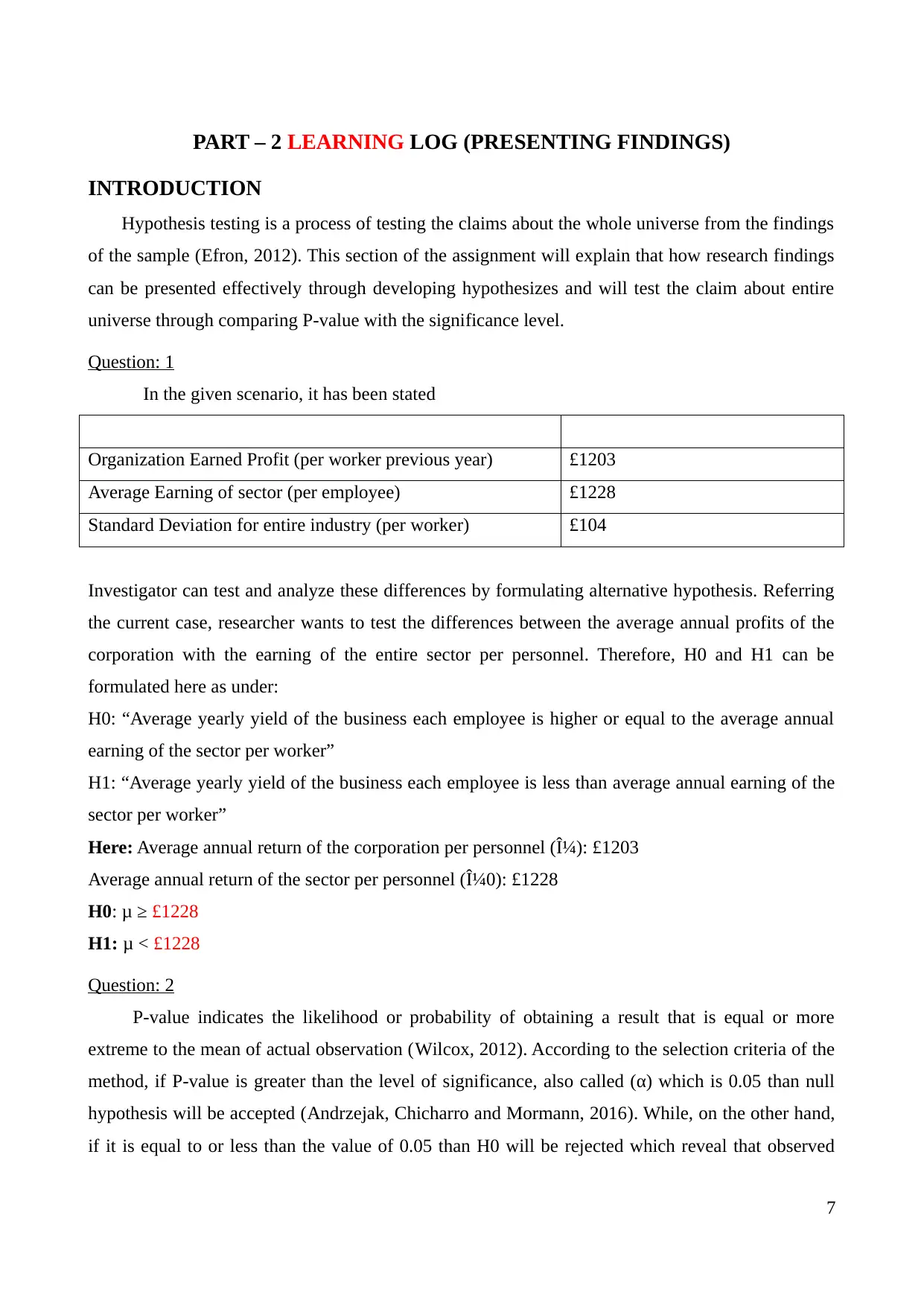
PART – 2 LEARNING LOG (PRESENTING FINDINGS)
INTRODUCTION
Hypothesis testing is a process of testing the claims about the whole universe from the findings
of the sample (Efron, 2012). This section of the assignment will explain that how research findings
can be presented effectively through developing hypothesizes and will test the claim about entire
universe through comparing P-value with the significance level.
Question: 1
In the given scenario, it has been stated
Organization Earned Profit (per worker previous year) £1203
Average Earning of sector (per employee) £1228
Standard Deviation for entire industry (per worker) £104
Investigator can test and analyze these differences by formulating alternative hypothesis. Referring
the current case, researcher wants to test the differences between the average annual profits of the
corporation with the earning of the entire sector per personnel. Therefore, H0 and H1 can be
formulated here as under:
H0: “Average yearly yield of the business each employee is higher or equal to the average annual
earning of the sector per worker”
H1: “Average yearly yield of the business each employee is less than average annual earning of the
sector per worker”
Here: Average annual return of the corporation per personnel (μ): £1203
Average annual return of the sector per personnel (μ0): £1228
H0: μ ≥ £1228
H1: μ < £1228
Question: 2
P-value indicates the likelihood or probability of obtaining a result that is equal or more
extreme to the mean of actual observation (Wilcox, 2012). According to the selection criteria of the
method, if P-value is greater than the level of significance, also called (α) which is 0.05 than null
hypothesis will be accepted (Andrzejak, Chicharro and Mormann, 2016). While, on the other hand,
if it is equal to or less than the value of 0.05 than H0 will be rejected which reveal that observed
7
INTRODUCTION
Hypothesis testing is a process of testing the claims about the whole universe from the findings
of the sample (Efron, 2012). This section of the assignment will explain that how research findings
can be presented effectively through developing hypothesizes and will test the claim about entire
universe through comparing P-value with the significance level.
Question: 1
In the given scenario, it has been stated
Organization Earned Profit (per worker previous year) £1203
Average Earning of sector (per employee) £1228
Standard Deviation for entire industry (per worker) £104
Investigator can test and analyze these differences by formulating alternative hypothesis. Referring
the current case, researcher wants to test the differences between the average annual profits of the
corporation with the earning of the entire sector per personnel. Therefore, H0 and H1 can be
formulated here as under:
H0: “Average yearly yield of the business each employee is higher or equal to the average annual
earning of the sector per worker”
H1: “Average yearly yield of the business each employee is less than average annual earning of the
sector per worker”
Here: Average annual return of the corporation per personnel (μ): £1203
Average annual return of the sector per personnel (μ0): £1228
H0: μ ≥ £1228
H1: μ < £1228
Question: 2
P-value indicates the likelihood or probability of obtaining a result that is equal or more
extreme to the mean of actual observation (Wilcox, 2012). According to the selection criteria of the
method, if P-value is greater than the level of significance, also called (α) which is 0.05 than null
hypothesis will be accepted (Andrzejak, Chicharro and Mormann, 2016). While, on the other hand,
if it is equal to or less than the value of 0.05 than H0 will be rejected which reveal that observed
7
Paraphrase This Document
Need a fresh take? Get an instant paraphrase of this document with our AI Paraphraser
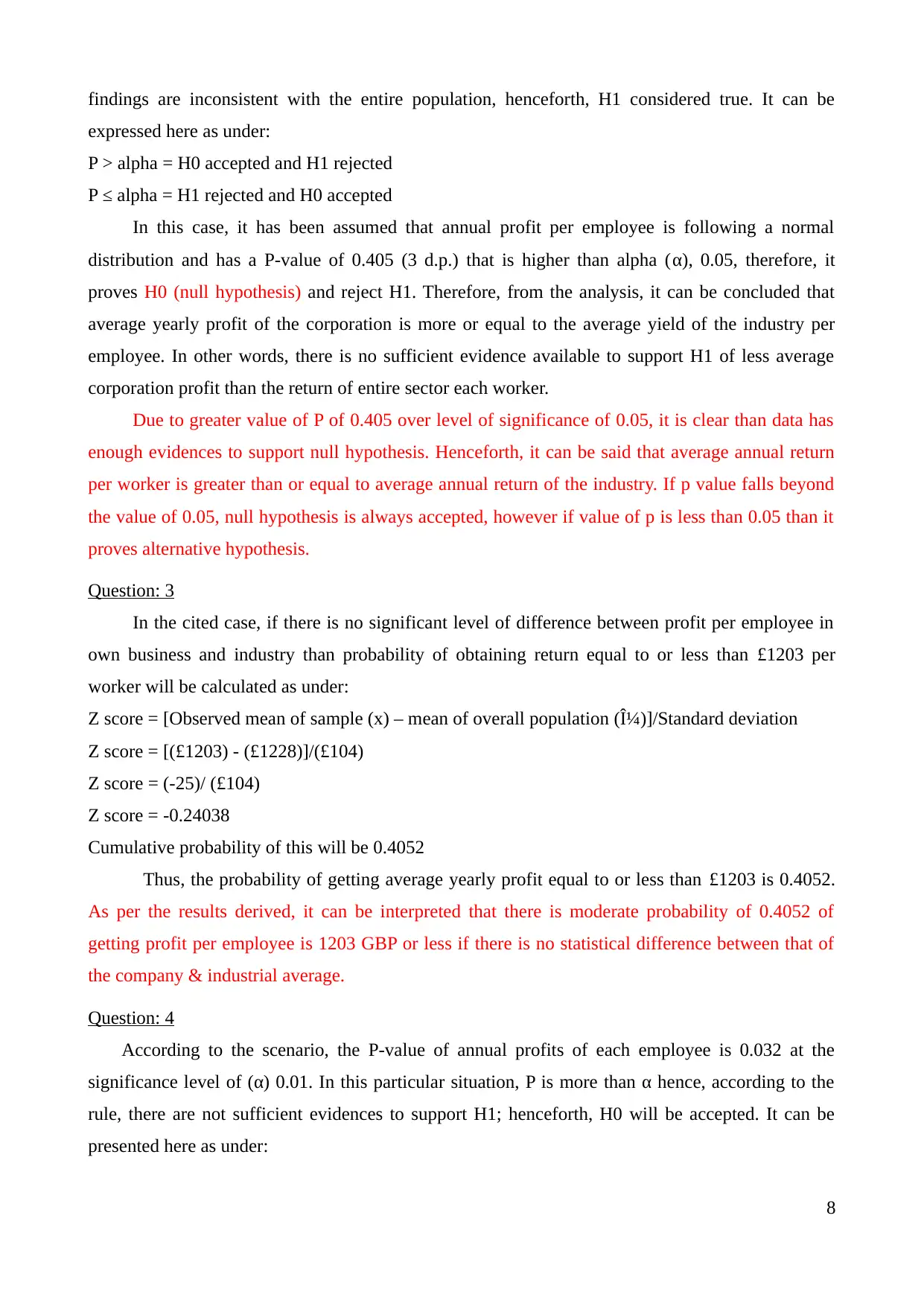
findings are inconsistent with the entire population, henceforth, H1 considered true. It can be
expressed here as under:
P > alpha = H0 accepted and H1 rejected
P ≤ alpha = H1 rejected and H0 accepted
In this case, it has been assumed that annual profit per employee is following a normal
distribution and has a P-value of 0.405 (3 d.p.) that is higher than alpha (α), 0.05, therefore, it
proves H0 (null hypothesis) and reject H1. Therefore, from the analysis, it can be concluded that
average yearly profit of the corporation is more or equal to the average yield of the industry per
employee. In other words, there is no sufficient evidence available to support H1 of less average
corporation profit than the return of entire sector each worker.
Due to greater value of P of 0.405 over level of significance of 0.05, it is clear than data has
enough evidences to support null hypothesis. Henceforth, it can be said that average annual return
per worker is greater than or equal to average annual return of the industry. If p value falls beyond
the value of 0.05, null hypothesis is always accepted, however if value of p is less than 0.05 than it
proves alternative hypothesis.
Question: 3
In the cited case, if there is no significant level of difference between profit per employee in
own business and industry than probability of obtaining return equal to or less than £1203 per
worker will be calculated as under:
Z score = [Observed mean of sample (x) – mean of overall population (μ)]/Standard deviation
Z score = [(£1203) - (£1228)]/(£104)
Z score = (-25)/ (£104)
Z score = -0.24038
Cumulative probability of this will be 0.4052
Thus, the probability of getting average yearly profit equal to or less than £1203 is 0.4052.
As per the results derived, it can be interpreted that there is moderate probability of 0.4052 of
getting profit per employee is 1203 GBP or less if there is no statistical difference between that of
the company & industrial average.
Question: 4
According to the scenario, the P-value of annual profits of each employee is 0.032 at the
significance level of (α) 0.01. In this particular situation, P is more than α hence, according to the
rule, there are not sufficient evidences to support H1; henceforth, H0 will be accepted. It can be
presented here as under:
8
expressed here as under:
P > alpha = H0 accepted and H1 rejected
P ≤ alpha = H1 rejected and H0 accepted
In this case, it has been assumed that annual profit per employee is following a normal
distribution and has a P-value of 0.405 (3 d.p.) that is higher than alpha (α), 0.05, therefore, it
proves H0 (null hypothesis) and reject H1. Therefore, from the analysis, it can be concluded that
average yearly profit of the corporation is more or equal to the average yield of the industry per
employee. In other words, there is no sufficient evidence available to support H1 of less average
corporation profit than the return of entire sector each worker.
Due to greater value of P of 0.405 over level of significance of 0.05, it is clear than data has
enough evidences to support null hypothesis. Henceforth, it can be said that average annual return
per worker is greater than or equal to average annual return of the industry. If p value falls beyond
the value of 0.05, null hypothesis is always accepted, however if value of p is less than 0.05 than it
proves alternative hypothesis.
Question: 3
In the cited case, if there is no significant level of difference between profit per employee in
own business and industry than probability of obtaining return equal to or less than £1203 per
worker will be calculated as under:
Z score = [Observed mean of sample (x) – mean of overall population (μ)]/Standard deviation
Z score = [(£1203) - (£1228)]/(£104)
Z score = (-25)/ (£104)
Z score = -0.24038
Cumulative probability of this will be 0.4052
Thus, the probability of getting average yearly profit equal to or less than £1203 is 0.4052.
As per the results derived, it can be interpreted that there is moderate probability of 0.4052 of
getting profit per employee is 1203 GBP or less if there is no statistical difference between that of
the company & industrial average.
Question: 4
According to the scenario, the P-value of annual profits of each employee is 0.032 at the
significance level of (α) 0.01. In this particular situation, P is more than α hence, according to the
rule, there are not sufficient evidences to support H1; henceforth, H0 will be accepted. It can be
presented here as under:
8
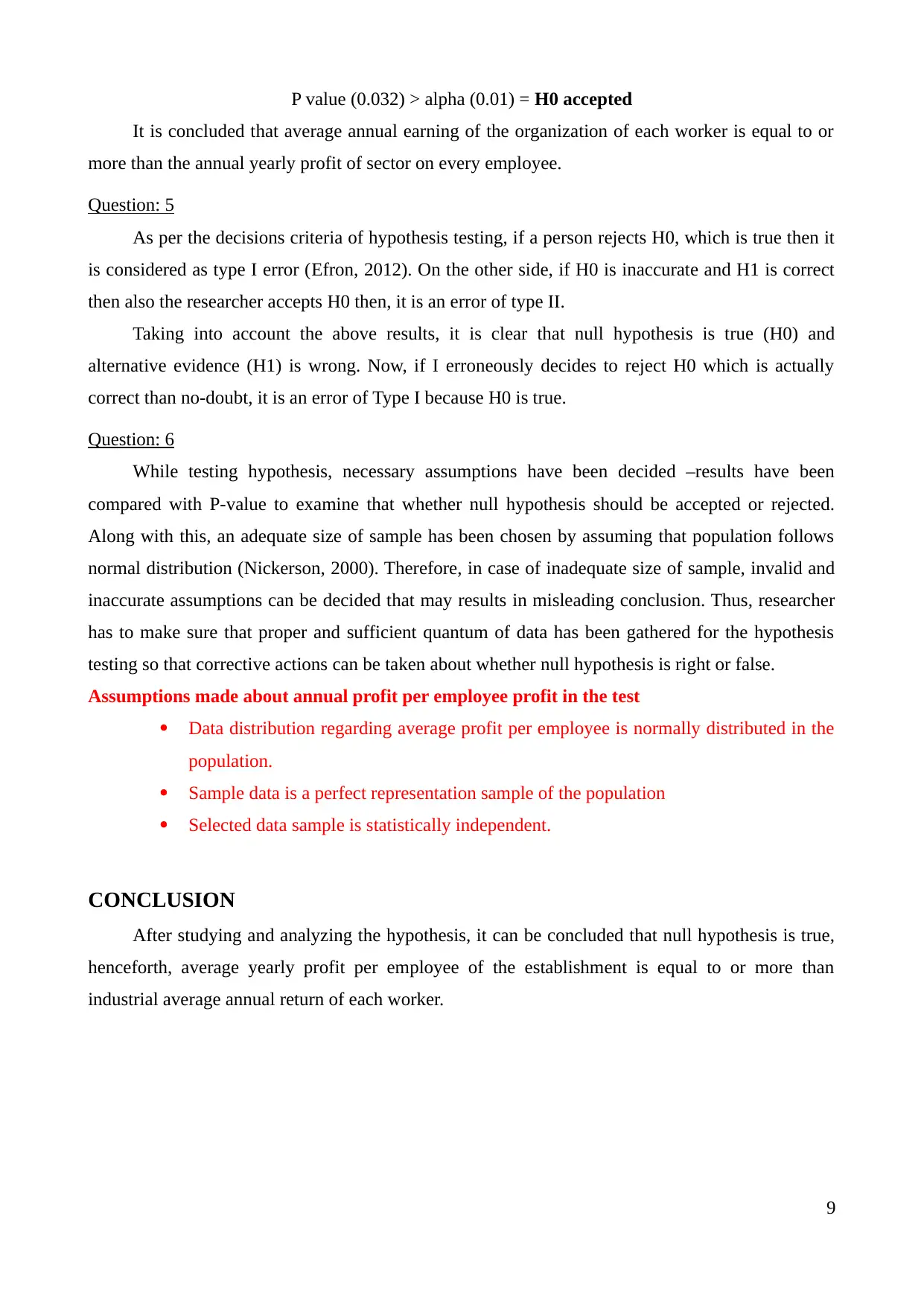
P value (0.032) > alpha (0.01) = H0 accepted
It is concluded that average annual earning of the organization of each worker is equal to or
more than the annual yearly profit of sector on every employee.
Question: 5
As per the decisions criteria of hypothesis testing, if a person rejects H0, which is true then it
is considered as type I error (Efron, 2012). On the other side, if H0 is inaccurate and H1 is correct
then also the researcher accepts H0 then, it is an error of type II.
Taking into account the above results, it is clear that null hypothesis is true (H0) and
alternative evidence (H1) is wrong. Now, if I erroneously decides to reject H0 which is actually
correct than no-doubt, it is an error of Type I because H0 is true.
Question: 6
While testing hypothesis, necessary assumptions have been decided –results have been
compared with P-value to examine that whether null hypothesis should be accepted or rejected.
Along with this, an adequate size of sample has been chosen by assuming that population follows
normal distribution (Nickerson, 2000). Therefore, in case of inadequate size of sample, invalid and
inaccurate assumptions can be decided that may results in misleading conclusion. Thus, researcher
has to make sure that proper and sufficient quantum of data has been gathered for the hypothesis
testing so that corrective actions can be taken about whether null hypothesis is right or false.
Assumptions made about annual profit per employee profit in the test
Data distribution regarding average profit per employee is normally distributed in the
population.
Sample data is a perfect representation sample of the population
Selected data sample is statistically independent.
CONCLUSION
After studying and analyzing the hypothesis, it can be concluded that null hypothesis is true,
henceforth, average yearly profit per employee of the establishment is equal to or more than
industrial average annual return of each worker.
9
It is concluded that average annual earning of the organization of each worker is equal to or
more than the annual yearly profit of sector on every employee.
Question: 5
As per the decisions criteria of hypothesis testing, if a person rejects H0, which is true then it
is considered as type I error (Efron, 2012). On the other side, if H0 is inaccurate and H1 is correct
then also the researcher accepts H0 then, it is an error of type II.
Taking into account the above results, it is clear that null hypothesis is true (H0) and
alternative evidence (H1) is wrong. Now, if I erroneously decides to reject H0 which is actually
correct than no-doubt, it is an error of Type I because H0 is true.
Question: 6
While testing hypothesis, necessary assumptions have been decided –results have been
compared with P-value to examine that whether null hypothesis should be accepted or rejected.
Along with this, an adequate size of sample has been chosen by assuming that population follows
normal distribution (Nickerson, 2000). Therefore, in case of inadequate size of sample, invalid and
inaccurate assumptions can be decided that may results in misleading conclusion. Thus, researcher
has to make sure that proper and sufficient quantum of data has been gathered for the hypothesis
testing so that corrective actions can be taken about whether null hypothesis is right or false.
Assumptions made about annual profit per employee profit in the test
Data distribution regarding average profit per employee is normally distributed in the
population.
Sample data is a perfect representation sample of the population
Selected data sample is statistically independent.
CONCLUSION
After studying and analyzing the hypothesis, it can be concluded that null hypothesis is true,
henceforth, average yearly profit per employee of the establishment is equal to or more than
industrial average annual return of each worker.
9
⊘ This is a preview!⊘
Do you want full access?
Subscribe today to unlock all pages.

Trusted by 1+ million students worldwide
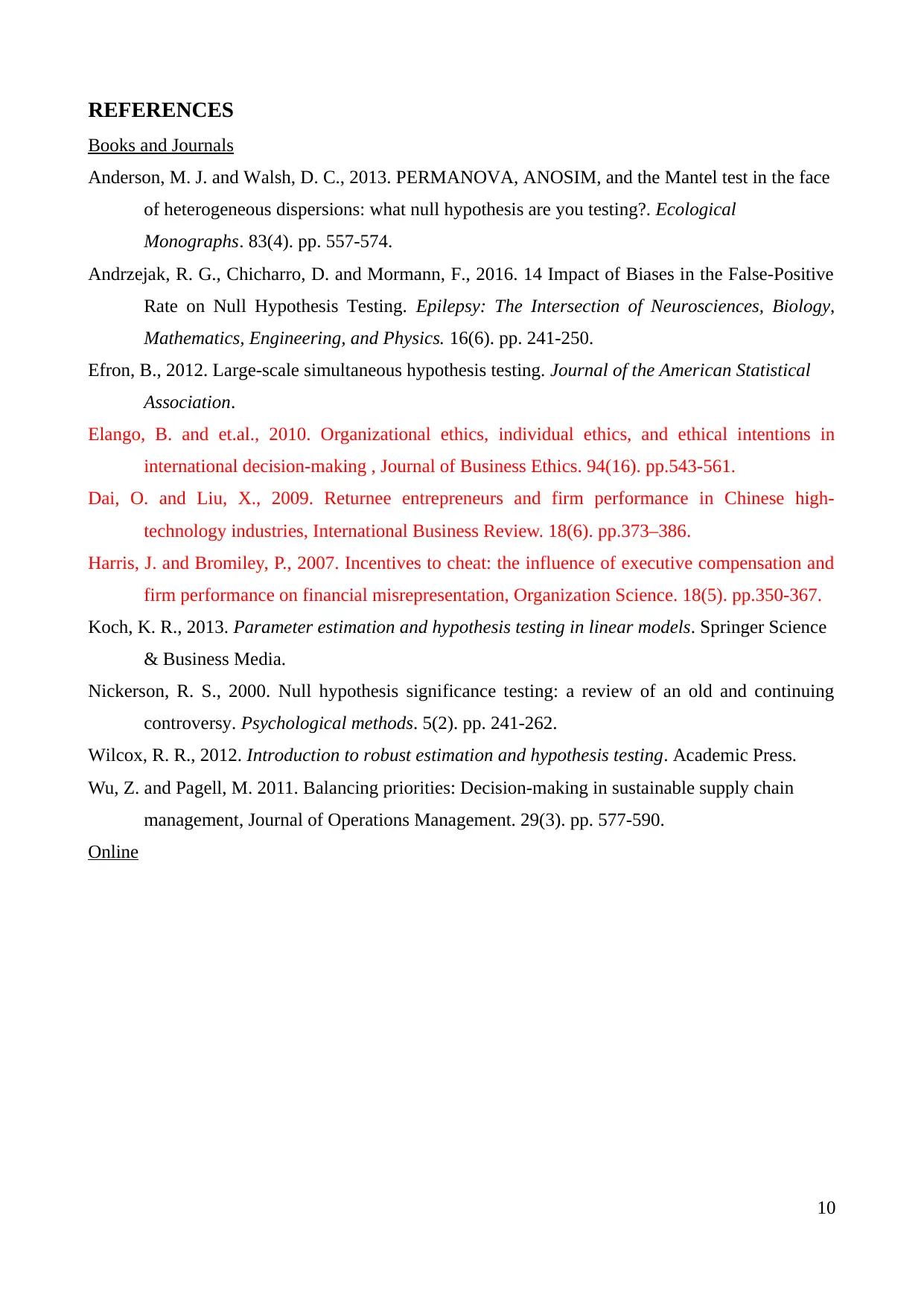
REFERENCES
Books and Journals
Anderson, M. J. and Walsh, D. C., 2013. PERMANOVA, ANOSIM, and the Mantel test in the face
of heterogeneous dispersions: what null hypothesis are you testing?. Ecological
Monographs. 83(4). pp. 557-574.
Andrzejak, R. G., Chicharro, D. and Mormann, F., 2016. 14 Impact of Biases in the False-Positive
Rate on Null Hypothesis Testing. Epilepsy: The Intersection of Neurosciences, Biology,
Mathematics, Engineering, and Physics. 16(6). pp. 241-250.
Efron, B., 2012. Large-scale simultaneous hypothesis testing. Journal of the American Statistical
Association.
Elango, B. and et.al., 2010. Organizational ethics, individual ethics, and ethical intentions in
international decision-making , Journal of Business Ethics. 94(16). pp.543-561.
Dai, O. and Liu, X., 2009. Returnee entrepreneurs and firm performance in Chinese high-
technology industries, International Business Review. 18(6). pp.373–386.
Harris, J. and Bromiley, P., 2007. Incentives to cheat: the influence of executive compensation and
firm performance on financial misrepresentation, Organization Science. 18(5). pp.350-367.
Koch, K. R., 2013. Parameter estimation and hypothesis testing in linear models. Springer Science
& Business Media.
Nickerson, R. S., 2000. Null hypothesis significance testing: a review of an old and continuing
controversy. Psychological methods. 5(2). pp. 241-262.
Wilcox, R. R., 2012. Introduction to robust estimation and hypothesis testing. Academic Press.
Wu, Z. and Pagell, M. 2011. Balancing priorities: Decision-making in sustainable supply chain
management, Journal of Operations Management. 29(3). pp. 577-590.
Online
10
Books and Journals
Anderson, M. J. and Walsh, D. C., 2013. PERMANOVA, ANOSIM, and the Mantel test in the face
of heterogeneous dispersions: what null hypothesis are you testing?. Ecological
Monographs. 83(4). pp. 557-574.
Andrzejak, R. G., Chicharro, D. and Mormann, F., 2016. 14 Impact of Biases in the False-Positive
Rate on Null Hypothesis Testing. Epilepsy: The Intersection of Neurosciences, Biology,
Mathematics, Engineering, and Physics. 16(6). pp. 241-250.
Efron, B., 2012. Large-scale simultaneous hypothesis testing. Journal of the American Statistical
Association.
Elango, B. and et.al., 2010. Organizational ethics, individual ethics, and ethical intentions in
international decision-making , Journal of Business Ethics. 94(16). pp.543-561.
Dai, O. and Liu, X., 2009. Returnee entrepreneurs and firm performance in Chinese high-
technology industries, International Business Review. 18(6). pp.373–386.
Harris, J. and Bromiley, P., 2007. Incentives to cheat: the influence of executive compensation and
firm performance on financial misrepresentation, Organization Science. 18(5). pp.350-367.
Koch, K. R., 2013. Parameter estimation and hypothesis testing in linear models. Springer Science
& Business Media.
Nickerson, R. S., 2000. Null hypothesis significance testing: a review of an old and continuing
controversy. Psychological methods. 5(2). pp. 241-262.
Wilcox, R. R., 2012. Introduction to robust estimation and hypothesis testing. Academic Press.
Wu, Z. and Pagell, M. 2011. Balancing priorities: Decision-making in sustainable supply chain
management, Journal of Operations Management. 29(3). pp. 577-590.
Online
10
1 out of 10
Related Documents
Your All-in-One AI-Powered Toolkit for Academic Success.
+13062052269
info@desklib.com
Available 24*7 on WhatsApp / Email
![[object Object]](/_next/static/media/star-bottom.7253800d.svg)
Unlock your academic potential
Copyright © 2020–2025 A2Z Services. All Rights Reserved. Developed and managed by ZUCOL.




